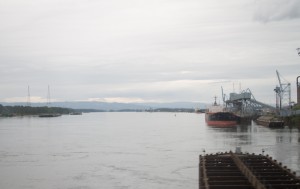My particular view of the water world is constrained by scarcity. We don’t move a lot of cargo on the Rio Grande or the Colorado, the two rivers in my immediate field of view.
I forget, and our current trip to the Pacific Northwest has reminded me, of the magic of water in service of the movement of people and goods. Rivers and oceans provide smooth, low-friction roadways to move large quantities of stuff. (Steve Solomon’s Water: The Epic Struggle for Wealth, Power, and Civilization does a nice job of laying out the big picture here.)
This photograph is either the Willamette or the Columbia, taken by Lissa from the Amtrak as we crossed both in quick succession. In 2012, the Port of Portland shipped 4 million tons of wheat. (source: pdf) That’s enough for more than a pound of wheat for every human on the planet. In some small ways, as a young man I helped farmers out in eastern Washington to grow wheat. It most likely was shipped down the Columbia River, ending up at terminals at the Port of Portland, where the Willamette and Columbia meet upstream of the Pacific Ocean.
Portland and Seattle had a bit of a contest in the 19th century to become the Pacific Northwest’s dominant port. A lot of the struggle involved the usual 19th century scam of connecting up with a railroad
, but in the end they both ended up with major ports and they both prospered.
This is all good for me to remember. They don’t ship a lot of wheat on the Rio Grande.


In the old days on the Eastern Shore of MD where I used to live, shallow-draft sailing vessels of various kinds were used to move people and goods up and down the wide tidal rivers. Horses and wagons transported cargo from the docks to scores of tiny railroad spurs. A nicer way to live, for certain.
There are organizations in the PNW promoting or planning for the return of wind-powered transportation and commerce along the coast, or at least there were. I remember hearing of them several years ago but have lost the links.